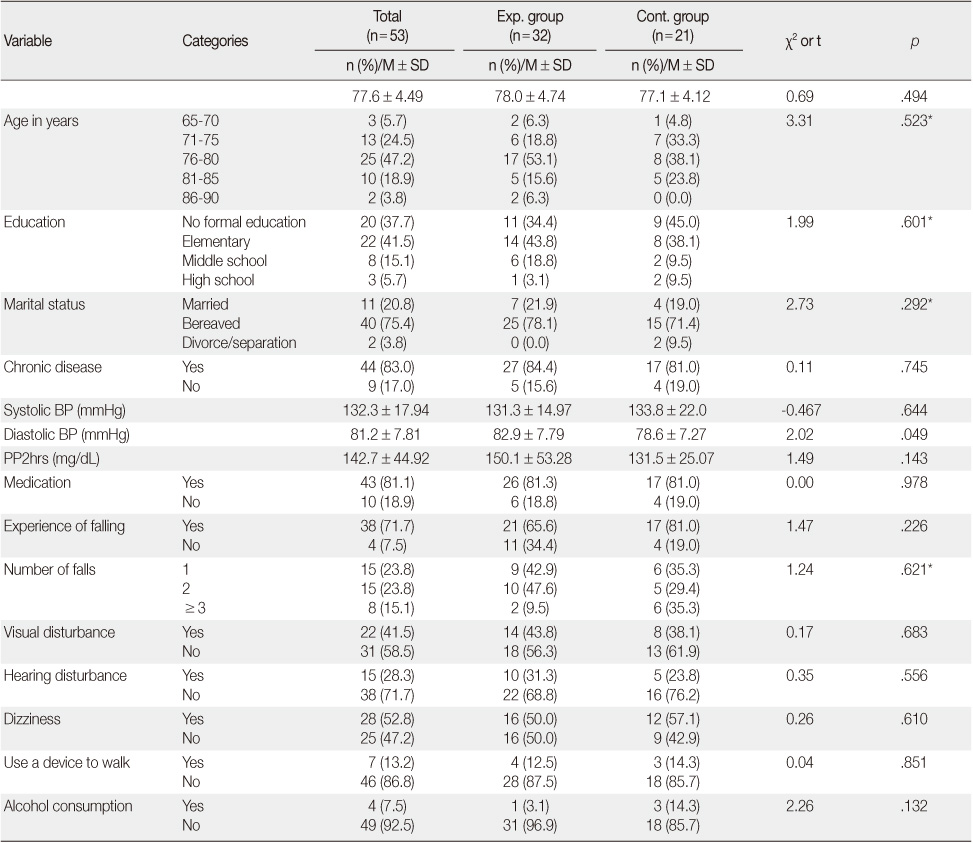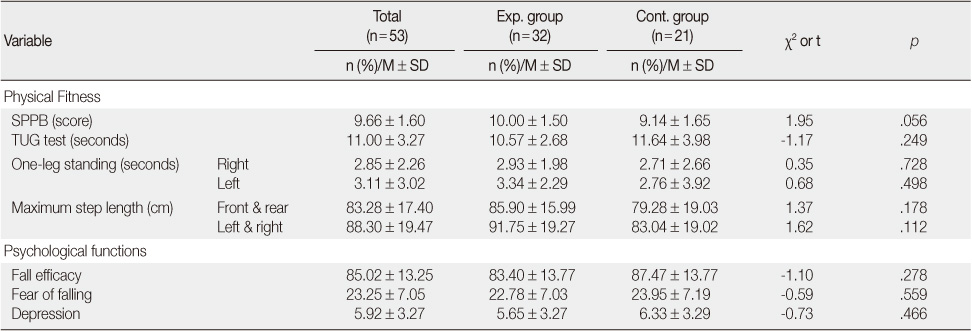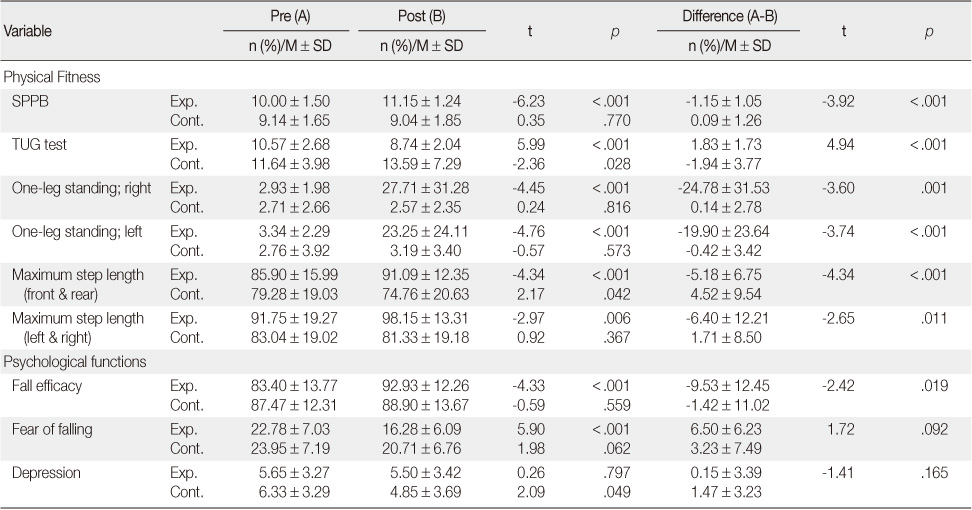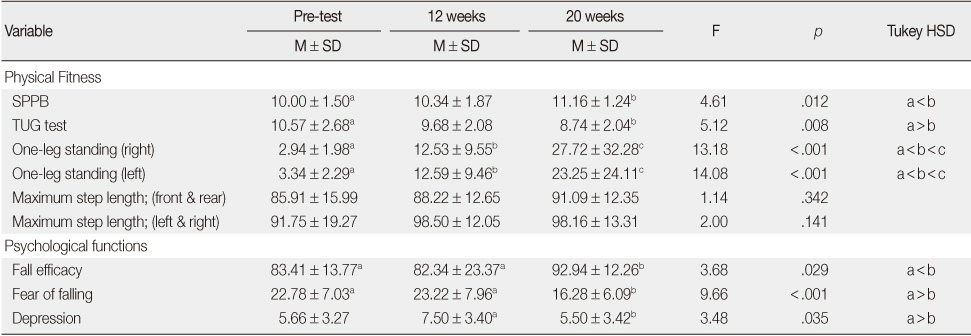Articles
- Page Path
- HOME > J Korean Acad Nurs > Volume 41(2); 2011 > Article
-
Original Article
- Effects of a Fall Prevention Program on Physical Fitness and Psychological Functions in Community Dwelling Elders
- Myung Soon Kwon
-
Journal of Korean Academy of Nursing 2011;41(2):165-174.
DOI: https://doi.org/10.4040/jkan.2011.41.2.165
Published online: April 30, 2011
Associate Professor, Department of Nursing, Hallym University, Chuncheon, Korea.
- Address reprint requests to: Kwon, Myung Soon. Department of Nursing, Hallym University, 39 Hallimdaehak-gil, Chuncheon 200-702, Korea. Tel: +82-33-248-2719, Fax: +82-33-248-2734, kwon1314@hallym.ac.kr
© 2011 Korean Society of Nursing Science
Figure & Data
REFERENCES
Citations

- Effects of a fall prevention exercise regimen on physical and psychosocial outcomes in elderly community dwellers: a randomized comparative study
Ji-Yeon Sim, Jung-Wan Koo, Yeon-Gyu Jeong
Physiotherapy Theory and Practice.2025; 41(2): 252. CrossRef - Effectiveness of exercise prescription variables to reduce fall risk among older adults: a meta-analysis
Tian-Rui Zhu, Hong-Qi Xu, Jin-Peng Wei, He-Long Quan, Xue-Jiao Han, Tian-Xiang Li, Ji-Peng Shi
European Review of Aging and Physical Activity.2025;[Epub] CrossRef - Effects of Fall Prevention Elastic Band Exercise on Physical Function Test, Grasp Power, Flexibility, and Muscle Volume in Older Women
Young-Eun Song
Journal of Korean Association of Physical Education and Sport for Girls and Women.2023; 37(1): 37. CrossRef - Cognitive behavioural therapy (CBT) with and without exercise to reduce fear of falling in older people living in the community
Eric Lenouvel, Phoebe Ullrich, Waldemar Siemens, Dhayana Dallmeier, Michael Denkinger, Gunver Kienle, G A Rixt Zijlstra, Klaus Hauer, Stefan Klöppel
Cochrane Database of Systematic Reviews.2023;[Epub] CrossRef - Effects of a Stim up Mat Walking Exercise Program on Balance, Gait Function and Joint Motion Range of the Frail Elderly
Gyeong Ran Kim, Mi Sook Song
Journal of Korean Academy of Community Health Nursing.2019; 30(1): 47. CrossRef - Effect of Strength Exercise on Patient Fall Prevention Program: Focusing on the Fall High Risk Group Elderly Patients
Hyun-Ok Lee, Byung-Hwa Lee, Chang-Hee Lee
Journal of Health Informatics and Statistics.2017; 42(4): 338. CrossRef - Effects of elastic-band resistance exercise on balance, mobility and gait function, flexibility and fall efficacy in elderly people
Cheol-Jin Kwak, You Lim Kim, Suk Min Lee
Journal of Physical Therapy Science.2016; 28(11): 3189. CrossRef - The Effect of a Comprehensive Intervention Program on the Functional Status and Bone Density of the Socially-Vulnerable and Frail Elderly
In Sook Lee, Kwang Ok Lee
Journal of Korean Academy of Community Health Nursing.2016; 27(1): 51. CrossRef - Effect of Tai-Chi on Grip Power, Pain and Fear of Falling in Elderly Person
Chung-uk Oh
Journal of the Korea Academia-Industrial cooperation Society.2016; 17(5): 631. CrossRef - Effects of a Thera-Band Exercise Program on Pain, Knee Flexion ROM, and Psychological Parameters Following Total Knee Arthroplasty
Ji Yeong Yun, Jong Kyung Lee
Journal of Korean Academy of Nursing.2015; 45(6): 823. CrossRef - Strategies on fall prevention for older people living in the community: A report from a round-table meeting in IAGG 2013
Eun Joo Kim, Hidenori Arai, Piu Chan, Liang-Kung Chen, Keith D. Hill, Bernard Kong, Philip Poi, Maw Pin Tan, Hyung Joon Yoo, Chang Won Won
Journal of Clinical Gerontology and Geriatrics.2015; 6(2): 39. CrossRef - Fall Risk in the Community-dwelling Elderly who Received Home Care Services: Focused on Residential Environment and Perception of Fall Risk
Chong Mi Lee, Bok-Hee Cho
Journal of muscle and joint health.2014; 21(1): 36. CrossRef - Exercise for reducing fear of falling in older people living in the community
Denise Kendrick, Arun Kumar, Hannah Carpenter, G A Rixt Zijlstra, Dawn A Skelton, Juliette R Cook, Zoe Stevens, Carolyn M Belcher, Deborah Haworth, Sheena J Gawler, Heather Gage, Tahir Masud, Ann Bowling, Mirilee Pearl, Richard W Morris, Steve Iliffe, Kim
Cochrane Database of Systematic Reviews.2014;[Epub] CrossRef - Effects of Community-based Comprehensive Fall Prevention Program on Muscle Strength, Postural Balance and Fall Efficacy in Elderly People
Jeongyee Bae, Seong-il Cho
Journal of Korean Academy of Nursing.2014; 44(6): 697. CrossRef - Effects of a Randomized Controlled Recurrent Fall Prevention Program on Risk Factors for Falls in Frail Elderly Living at Home in Rural Communities
JongEun Yim
Medical Science Monitor.2014; 20: 2283. CrossRef - Fall Experience and Risk Factors for Falls among the Community-dwelling Elderly
Young Hee Kim, Kyung Hee Yang, Kum Sook Park
Journal of muscle and joint health.2013; 20(2): 91. CrossRef - Risk Factors for Recurrent Falls Among Community-dwelling Elderly in Rural Areas
Mi-Yang Jeon, Sun Hee Yang
Journal of the Korea Academia-Industrial cooperation Society.2013; 14(12): 6353. CrossRef - Factors Associated with Nurses' Activities for Hospital Fall Prevention
In Kyoung Lee, Ja Yun Choi
The Korean Journal of Rehabilitation Nursing.2013; 16(1): 55. CrossRef - Effects of a Fall Prevention Program on Falls in Frail Elders Living at Home in Rural Communities
Jae-Soon Yoo, Mi Yang Jeon, Chul-Gyu Kim
Journal of Korean Academy of Nursing.2013; 43(5): 613. CrossRef - Effects of a Fall Prevention Program on Physical Functions and Psychological Functions in Rural Elderly Women
Sung-Min Kim, Go-Ya Choi
The Korean Journal of Rehabilitation Nursing.2012; 15(1): 63. CrossRef - Effect of the Tai Chi Fall Prevention Program for Elderly Women Living in the Community
In Sook Park, Hee Young So, Rhayun Song, Hyunli Kim, Sukhee Ahn
Journal of muscle and joint health.2012; 19(3): 282. CrossRef - Effects of a Health Diary Program on Fall-Related Outcomes in Low-Income Elderly Women with Osteoarthritis
Myung-Suk Lee
Journal of agricultural medicine and community health.2011; 36(3): 167. CrossRef
Homogeneity Test for General Characteristics and Health related Characteristics
*Fisher's exact test; Exp.=experimental; Cont.=control; BP=blood pressure; PP2hrs=postprandial blood sugar.
Homogeneity Test for Physical Fitness & Psychological Functions
Exp=experimental; Cont=control; SPPB=short physical performance battery; TUG test=timed up & go test.
Differences of Physical Fitness and Psychological Functions
Pre=pre-test; Post=post-test; Exp=experimental group; Cont=control group; SPPB=short physical performance battery; TUG test=timed up & go test.
Differences of Physical Fitness and Psychological Functions according to Time in the Experimental Group
SPPB=short physical performance battery; TUG test=timed up & go test.
*Fisher's exact test; Exp.=experimental; Cont.=control; BP=blood pressure; PP2hrs=postprandial blood sugar.
Exp=experimental; Cont=control; SPPB=short physical performance battery; TUG test=timed up & go test.
Pre=pre-test; Post=post-test; Exp=experimental group; Cont=control group; SPPB=short physical performance battery; TUG test=timed up & go test.
SPPB=short physical performance battery; TUG test=timed up & go test.
 KSNS
KSNS
 E-SUBMISSION
E-SUBMISSION




 Cite
Cite

